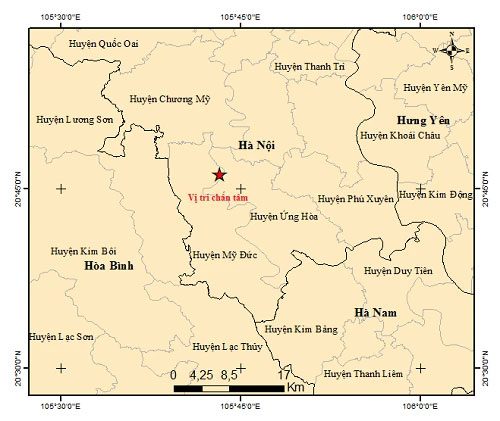On March 25, residents in several areas of My Duc District (Hanoi) reported experiencing strong tremors, suspected to be aftershocks from an earthquake.
Video capturing the moment of the earthquake. (Source: Social Media).
In several urban districts such as Cau Giay, Ha Dong, and Thanh Xuan, residents also felt clear tremors occurring consecutively 2-3 times.
In an interview with a reporter from VietnamPlus, expert Nguyen Xuan Anh – Director of the Institute of Geophysics (Vietnam Academy of Science and Technology) stated that the tremors were due to aftershocks from a magnitude 4 earthquake that just occurred in My Duc District, Hanoi.

Map of the epicenter of the earthquake in My Duc District, Hanoi. (Source: Institute of Geophysics).
According to expert Nguyen Xuan Anh, the earthquake occurred at 8:05 AM today, March 25. The depth of the earthquake’s focus was about 16 km.
The director of the Institute of Geophysics also noted that earthquakes below magnitude 5 are generally considered minor and rarely pose a natural disaster risk.
Earthquakes ranging from 5 to 6 are classified as medium-sized, with a risk of natural disaster. Magnitudes above 6 are considered large earthquakes, carrying a very high risk of disaster.
According to regulations, local authorities must inform the public in the affected areas of any earthquakes or tsunami warnings by any means necessary; organize evacuations, and mobilize resources to help residents reach safe areas; ensuring security and order in the region.
For residents, upon receiving news of an earthquake or tsunami warning, all citizens in the affected area must proactively evacuate from dangerous zones to ensure their safety.
Currently, the Earthquake Information Center and Tsunami Warning Center are still monitoring the developments of the magnitude 4 earthquake in My Duc District to provide timely updates to the media and local authorities.
In another development, sharing with VietnamPlus, Associate Professor – Dr. Cao Dinh Trieu – Vice President of the Vietnam Society of Geophysics (Director of the Applied Geophysics Institute) mentioned that Hanoi lies within the Red River – Chay River fault zone, where earthquakes of magnitudes 5.1 to 5.5 have occurred in the past.
The typical recurrence interval for a 5.3 magnitude earthquake in Hanoi is about 1,100 years, with the last significant earthquake occurring over 700 years ago (1285).
However, Mr. Trieu also warned that Hanoi is an area with poor soil quality, making it susceptible to significant earthquakes. If an earthquake occurs in the Red River – Chay River fault zone (which passes through Hanoi) with maximum recorded data at level 6, the natural impact could reach level 8.
“Therefore, if an earthquake occurs in Hanoi, it will cause significant tremors. Just a magnitude above 4 can make old apartment buildings and deteriorated collective housing in the city unable to withstand the shaking,” emphasized Mr. Trieu.
According to Mr. Trieu, besides the risk of large earthquakes, the Hanoi area is also prone to feeling tremors from significant earthquakes occurring elsewhere. Recent evidence shows that Hanoi has experienced tremors due to aftershocks from neighboring countries like Laos and China.
The most recent incident occurred around 8:43 PM on December 24, 2021, when many residents in high-rise buildings in Hanoi felt strong shaking. The cause was later identified as the result of a 5.5 magnitude earthquake in Laos.
In addition to aftershocks from abroad, numerous induced earthquakes have occurred in various localities across the country in recent years. Historically, Vietnam has also experienced a strong earthquake reaching 6.9 in the Dien Bien Basin (in 1935). Therefore, according to Mr. Trieu, the impact of aftershocks from significant domestic earthquakes is also a potential hidden risk.
From this reality, Mr. Trieu believes that in the future, Vietnam in general, and Hanoi in particular, need to pay more attention to earthquake resistance for construction projects, especially for residential buildings (such as high-rise apartments) to ensure safety and minimize potential risks affecting the public.
“I believe that we need to focus on strengthening and re-establishing the monitoring network of earthquake observation stations in Hanoi. This is very important because, recently, every time an earthquake occurs even from afar, many buildings shake, possibly due to the relatively weak foundations of structures in Hanoi,” shared Mr. Trieu.



















































